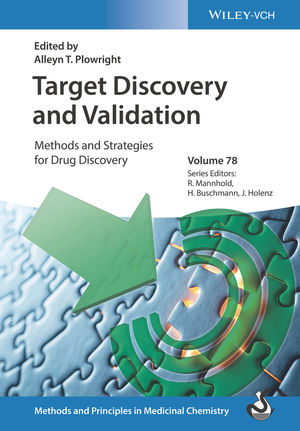توضیحات
Target Discovery and Target Discovery and
DESCRIPTION
The modern drug developers? guide for making informed choices among the diverse target identification methods
Target Discovery and Validation: Methods and Strategies for Drug Discovery offers a hands-on review of the modern technologies for drug target identification and validation. With contributions from noted industry and academic experts, the book addresses the most recent chemical, biological, and computational methods. Additionally, the book highlights techologies that are applicable to ?difficult? targets and drugs directed at multiple targets, including chemoproteomics, activity-based protein profiling, pathway mapping, genome-wide association studies, and array-based profiling.
Throughout, the authors highlight a range of diverse approaches, and target validation studies reveal how these methods can support academic and drug discovery scientists in their target discovery and validation research. This resource:
-Offers a guide to identifying and validating targets, a key enabling technology without which no new drug development is possible
-Presents the information needed for choosing the appropriate assay method from the ever-growing range of available options
-Provides practical examples from recent drug development projects, e. g. in kinase inhibitor profiling
Written for medicinal chemists, pharmaceutical professionals, biochemists, biotechnology professionals, and pharmaceutical chemists, Target Discovery and Validation explores the current methods for the identification and validation of drug targets in one comrpehensive volume. It also includes numerous practical examples.
ABOUT THE AUTHOR
Preface xiii
A Personal Foreword xvii
1 Chemical Strategies for Evaluating New Drug Targets 1
Adrian J. Carter, Raina Seupel, Paul E. Brennan, Michael Sundström, Andrea Introini, and Anke Mueller-Fahrnow
1.1 Introduction 1
1.2 Use Cases and Case Studies for Chemogenomic Compounds and Chemical Probes 5
1.2.1 Chemogenomic Libraries 5
1.2.2 Inactive Control 6
1.2.3 Use of Biological Target Panels and Profiling 8
1.3 Development of Chemical Probes 10
1.3.1 From BIX01294 to EPZ035544: Development and Improvement of G9a/GLP Inhibitors 10
1.3.2 Development of BRD9 Inhibitors 12
1.4 Compound-Based Target Evaluation with Patient-Derived Cells 14
1.4.1 Compound-Based Target Evaluation 14
1.4.2 Patient-Derived Cell Assays 16
1.4.3 Target Evaluation Approach 16
1.4.4 Case Story: Inflammatory Bowel Disease (IBD) Tissue Platform 18
1.5 Summary and Outlook 19
References 20
2 Affinity-Based Chemoproteomics for Target Identification 25
Annika Jenmalm Jensen and Ivan Cornella Taracido
2.1 Introduction 25
2.2 Small Molecule Phenotypic Mechanism of Action Elucidation 29
2.3 Quantitative High-Resolution Mass Spectrometry as a Protein Detection Read-Out 30
2.4 In-Lysate Affinity-Based Chemical Proteomics 33
2.4.1 Design of the Affinity Probe 34
2.4.2 General Experimental Pulldown Workflow 36
2.4.3 Limitations 38
2.5 In-Cell Light-Activated Affinity-Based Chemoproteomics 39
2.5.1 Design of the Reactive Photoaffinity Probe (PAL Probe) 40
2.5.2 General Experimental Workflow 40
2.5.3 Limitations 43
2.6 Target Validation and Mode of Action 43
2.7 Concluding Remarks 45
References 46
3 Activity-Based Protein Profiling 51
Nattawadee Panyain, Cassandra R. Kennedy, Ryan T. Howard, and Edward W. Tate
3.1 Introduction 51
3.2 Activity-Based Probe (ABP) and Affinity-Based Probe (AfBP) Design 53
3.2.1 Warheads (Reactive Groups) 53
3.2.1.1 Electrophilic Warheads 55
3.2.1.2 Photocrosslinking Warheads 55
3.2.2 Reporter Tags 56
3.2.3 Linkers 56
3.2.4 Bioorthogonal Ligation Chemistry 57
3.2.4.1 Staudinger Ligation 58
3.2.4.2 Copper(I)-Catalysed Azide-Alkyne Cycloaddition (CuAAC) 58
3.2.4.3 Strain-Promoted Azide-Alkyne Cycloaddition (SPAAC) 59
3.2.4.4 Diels–Alder Reaction 59
3.3 Chemical Proteomic Workflow 60
3.3.1 Quantitative Proteomics by Mass Spectrometry 61
3.3.1.1 Label-Free Quantification (LFQ) 61
3.3.1.2 Chemical Labelling Quantification 61
3.3.1.3 Metabolic Labelling Quantification 63
3.4 ABPP Applications and Case Studies 63
3.4.1 Case Study 1: Activity-Based Protein Profiling as a Robust Method for Enzyme Identification and Screening in Extremophilic Archaea 65
3.4.2 Case Study 2: Failed Clinical Trial of a Fatty Acid Amide Hydrolase (FAAH) Inhibitor 68
3.4.3 Case Study 3: Target Identification of Small Molecule Inhibitors 71
3.4.3.1 New Target Profiling for Sulforaphane 71
3.4.3.2 Profiling USP Inhibitors in Human Cell Lines as Potential Therapeutic Molecules 73
3.4.4 Case Study 4: Fragment-Based Ligand Discovery Aided by Photoaffinity Labelling 74
3.4.5 Case Study 5: Quenched Fluorescent Activity-Based Probe (qABP) Design and Application in Protein Localization 80
3.5 Summary 82
References 83
4 Kinobeads: A Chemical Proteomic Approach for Kinase Inhibitor Selectivity Profiling and Target Discovery 97
Maria Reinecke, Stephanie Heinzlmeir, Mathias Wilhelm, Guillaume Médard, Susan Klaeger, and Bernhard Kuster
4.1 Kinase Inhibitor Target Deconvolution Using Chemical Proteomics 97
4.1.1 Polypharmacology of Small Molecule Kinase Inhibitors 97
4.1.2 Chemoproteomic Profiling of Kinase Inhibitors 100
4.1.3 Tips and Tricks Regarding Chemoproteomic Assay Development 103
4.2 Detailed Kinobeads Protocol 105
4.2.1 Cell or Tissue Lysate 107
4.2.2 Affinity Matrices 107
4.2.3 Kinobeads Competition Assay 110
4.2.4 Mass Spectrometry 111
4.2.5 Peptide and Protein Identification and Quantification 112
4.2.6 Data Analysis 112
4.3 Application Examples for Kinobeads 113
4.3.1 Expanding the Target Space of Kinobeads 113
4.3.2 Target Space Deconvolution of Small Molecule Kinase Inhibitors 116
4.3.3 Opportunities Arising from Inhibitor Polypharmacology: Drug Repositioning 120
4.3.4 Chemoproteomic-Guided Medicinal Chemistry 121
4.4 Kinobeads, Inhibitors, and Drug Discovery: Where are We Heading? 123
4.4.1 What is a Good Drug? 123
4.4.2 How Can We Discover New Drugs in the Future? 124
4.4.3 The Yin and Yang of Chemoproteomic-Guided Drug Discovery 124
Acknowledgments 125
References 125
5 Label-Free Techniques for Target Discovery and Validation 131
Daniel Martinez Molina and Michael Dabrowski
5.1 Introduction 131
5.2 CETSA: How It All Began 132
5.3 The CETSA Formats 136
5.3.1 CETSA Classics 136
5.3.2 CETSA HT 138
5.3.3 CETSA MS 140
5.4 Target Discovery 142
5.4.1 Generation of Active Hit Molecules 142
5.4.2 Tool Generation (Small Screens to Identify Tool Compounds) 143
5.4.3 Target Classes That are In and Out of Scope and Difficult Targets 143
5.4.4 Focused or Iterative Library Screening 144
5.4.5 Fragment Library Screening 144
5.4.6 Hit Confirmation 145
5.4.7 Phenotypic Hit Deconvolution to Discover Targets 145
5.5 Target Validation 147
5.5.1 Binding Modes 147
5.5.2 Selectivity, Specificity, and Safety 148
5.5.3 Translation Bench to Bedside (via Animals) 149
5.6 Conclusion 150
References 151
6 Reverse Translation to Support Efficient Drug Target Selection and Stratified Medicine 153
Lauren Drowley and Martin Armstrong
6.1 Introduction: the Challenge 153
6.2 Genetics to Date in Drug Discovery 154
6.3 Genetic Strategies for Target Discovery 156
6.3.1 GWAS 158
6.3.2 Rare Disease Genetics 160
6.3.2.1 Rare Mutation→Rare Disease Drug Discovery 161
6.3.2.2 Rare Mutation→Common Disease Drug Discovery 161
6.3.3 Somatic Mutations 162
6.3.4 Analytical Approaches 163
6.4 Functional Validation 164
6.4.1 Prioritization of Putative Mutations 165
6.4.2 Determining Functional Consequence of Mutation 165
6.4.2.1 Publicly Available Data 165
6.4.2.2 Systems Biology 166
6.4.2.3 Model Systems: ‘The Tissue is the Issue’ 168
6.4.3 Druggability: From Validation of a Gene to a Druggable Target 169
6.5 Forward-Looking Perspectives 170
6.5.1 Molecular Taxonomy of Disease 171
6.5.2 Precision Medicine 171
6.5.3 Data Integration 172
6.6 Conclusion 173
References 173
7 Elucidating Target Biology and Drug Mechanism of Action Across Human Cell-Based Model Systems 179
John C. Dawson and Neil O. Carragher
7.1 Introduction 179
7.2 Advances in Human Cell-Based Model Development 182
7.2.1 Next-Generation Sequencing (NGS) 183
7.2.2 CRISPR Genome Editing 184
7.2.3 Induced Pluripotent Stem Cell Biology 184
7.2.4 3D Cell and Organoid Models 185
7.2.5 Microfluidic and Organ-on-a-Chip Devices 186
7.2.6 In Vivo Imaging 188
7.2.7 High-Content Imaging 190
7.3 Multiparametric High-Content Phenotypic Profiling of Target Biology and Drug Mechanism of Action 191
7.3.1 High-Content Cell Painting in Functional Genomics 193
7.3.2 Integration of Multiparametric High-Content Imaging with Chemoinformatics 195
7.3.3 Guiding Chemical Design and Target Selectivity from Multiparametric High-Content Analysis 195
7.4 Target-Annotated Compound Libraries for Phenotypic Screening and MOA Determination 196
7.5 Quantitative Pathway Profiling Across New Model Systems 197
7.5.1 Pathway Profiling at the Gene Transcription Level 198
7.5.2 Dynamic Post-Translational Pathway Profiling Across Dose–Response and Time-Series Studies 199
7.6 Conclusions 202
References 203
8 Cell Biology Methods in Target Validation 211
Manfred Koegl and Simon Wöhrle
8.1 Introduction 211
8.2 Biomarkers 211
8.2.1 Direct Target Engagement Biomarkers 212
8.2.2 Indirect Target Engagement Biomarkers and Pathway Biomarkers 213
8.2.3 Response Biomarkers 214
8.2.4 Correlation of Biomarkers 214
8.3 Direct Evidence to Show That Modulation of a Target Leads to a Cellular Response 219
8.4 Direct Evidence That Target Modulation is Responsible for Cellular Responses by Mutations Conferring Sensitivity to Existing Drugs 219
8.4.1 The ‘Bump-and-Hole’ Approach to Generate Sensitivity to Small Molecule Inhibitors 219
8.4.2 Chemogenomic Approaches for Inducible Degradation of Protein Targets 222
8.5 Resistance Conferring Mutations 226
References 229
9 Genetic Manipulation/Modulation for Target Discovery and Validation 233
Christophe Lanneau, Georges Kalouche, Xinming Cai, Francois Lo-Presti, and Christoph Potting
9.1 Introduction 233
9.2 Overview of the Development of Leading Genetic Manipulation Technologies 234
9.2.1 RNAi, ZFNs, and TALENs 234
9.2.2 Clustered Regularly Interspaced Short Palindromic Repeats (CRISPR) 237
9.3 Considerations for Designing and Interpreting CRISPR Experiments 238
9.3.1 Methodological Considerations for Genetic Manipulation by the CRISPR/Cas Technology 238
9.3.2 Choosing a Cellular Model: Biological and Genomic Aspects 239
9.3.3 gRNA Design 242
9.3.3.1 Identification of Target Locations 242
9.3.3.2 Selection of Spacer Sequences 245
9.3.3.3 Predictive Tools 247
9.3.4 Successful Application of the CRISPR/Cas Technology 249
9.3.4.1 Delivering CRISPR Reagents to Target Cells 249
9.3.4.2 Check for Anticipated Knockout/Knock-In 252
9.4 Further Developments of the CRISPR/Cas Technology Facilitates Additional Modes of Genetic Perturbation 253
9.4.1 CRISPRi 253
9.4.2 CRISPRa 253
9.4.3 Base Editing 254
9.5 The CRISPR/Cas Technology in Target Discovery and Validation 254
9.5.1 CRISPR/Cas Technology for Early Target Validation 254
9.5.2 CRISPR Screens and Use for Target Discovery 255
9.5.3 CRISPR Screens: General Principle and Considerations 256
9.5.4 Selected Examples of Target Discovery Using CRISPR Screens to Illustrate the Breadth of Applications 258
9.6 Application of CRISPR Genome Editing in Immunology Studies 260
9.7 Concluding Remarks 262
References 263
10 Computational Approaches for Target Inference 277
Gerhard Hessler, Christoph Grebner, and Hans Matter
10.1 Introduction 277
10.2 Data Annotation for Target Identification 278
10.3 In Silico Methods for Target Identification 280
10.3.1 2D Similarity Methods for Target Inference 283
10.3.2 3D Similarity Methods for Target Inference 289
10.3.3 Fragment-Based Approaches 290
10.3.4 QSAR Models and Machine Learning 292
10.3.5 Experimentally Derived Molecular Descriptors 297
10.3.6 Structure-Based Screening 299
10.3.7 Protein–Protein and Ligand–Target Networks 302
10.4 Practical Considerations 304
10.5 Conclusion 307
References 308
11 Bioinformatic Approaches in the Understanding of Mechanism of Action (MoA) 323
Maria-Anna Trapotsi, Ian Barrett, Ola Engkvist, and Andreas Bender
11.1 Bioinformatics: Introduction 323
11.1.1 Some Definitions: Mechanism Versus Mode of Action 323
11.1.2 Importance of MoA and Target Prediction in the Drug Discovery Process 324
11.1.3 Different Levels of Information in Mechanism of Action and Target Prediction 325
11.2 Transcriptomics Data and Databases 326
11.2.1 Biological Background of the Transcription Process 326
11.2.2 Connectivity Map: CMap 327
11.2.2.1 Applications of CMap in MoA Deconvolution 328
11.2.3 Library of Integrated Network-Based Cellular Signatures (LINCS) 331
11.2.3.1 LINCS L1000 Data Exploration 332
11.2.3.2 Applications of L1000 Data in MoA Understanding 333
11.3 Pathway Data and Databases 339
11.3.1 What is a Pathway? 339
11.3.2 Process of Pathway Analysis 341
11.3.3 Pathways in the Understanding of MoA 345
11.3.3.1 Methodology 1: MoA Analysis by Annotating Predicted Compounds’ Targets with Pathways 345
11.3.4 Combination of Gene Expression and Pathway Data 346
11.3.4.1 Methodology 2: Construction of Drug Networks (DNs) with Gene Expression Data and Pathway Annotations 346
11.3.4.2 Methodology 3: Link Drug Target and Pathway Activation to Understand MoA 347
11.4 Image-Based Data 348
11.4.1 Image Data and Where to Extract Them From 348
11.4.2 Application of Image-Based Data in Target Prediction and Better Understanding of MoA 350
11.4.2.1 Methodology 1: Clustering of Compounds Based on Cell Morphology 350
11.4.2.2 Methodology 2: Use of Image-Based Data in the Development of a Cell Morphology Database That Can Facilitate Drug Target Identification 350
11.4.2.3 Methodology 3: Use of Image Data in Drug Repositioning and Biological Activity Prediction 353
11.4.2.4 Methodology 4: Association of Genes with Context-Dependent Morphology Alterations from Cells Exposed to Chemical or Genetic Perturbations for MoA Elucidation 354
11.5 Conclusions 357
Acknowledgement 357
References 357
Index 365
source: wiley


 با خرید این محصول،
با خرید این محصول، 



نقد و بررسیها
هیچ دیدگاهی برای این محصول نوشته نشده است.